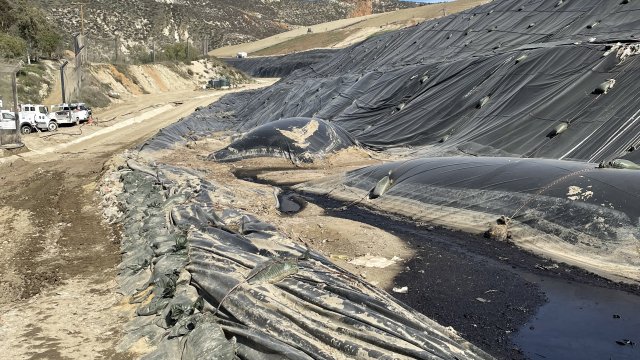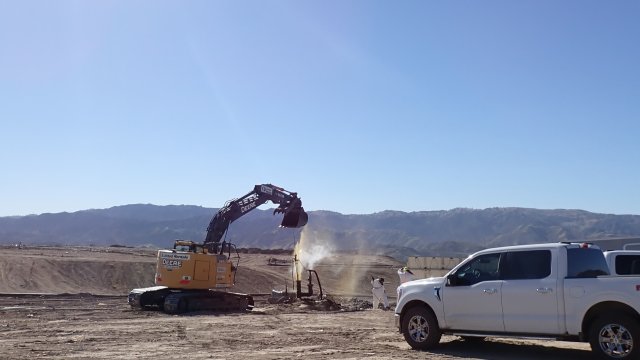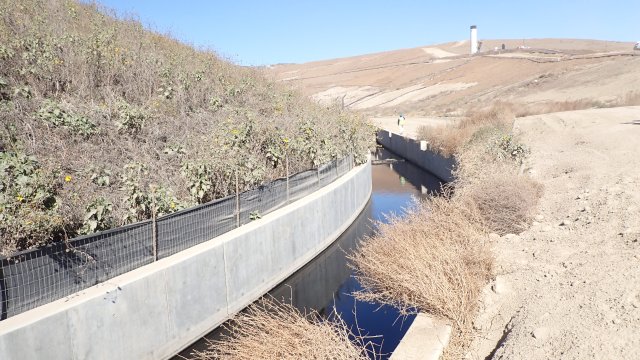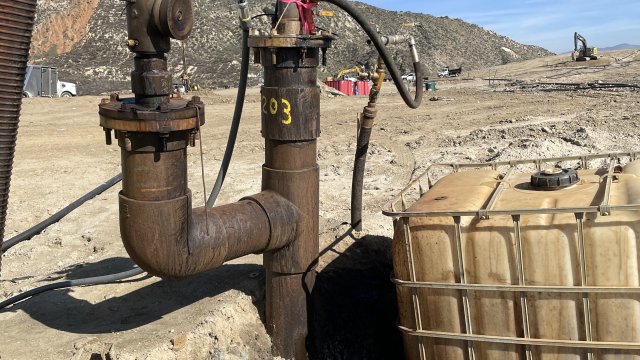Chiquita Canyon Landfill, Castaic, CA
- Latest Updates
- Facility Background
- Reaction Event History
- Inspection and Enforcement History
- Multi-Agency Coordination
- RCRA and CERCLA Unilateral Administrative Order (UAO)
- Links to Other Chiquita Canyon Landfill Websites
- Administrative Record
- Documents
- Facility Photos
Latest Updates
On June 4, 2024, EPA issued a Finding of Violation to Chiquita Canyon LLC under the Clean Air Act. EPA found that Chiquita Canyon LLC has, and continues to, violate the New Source Performance Standards and National Emission Standards for Hazardous Air Pollutants for municipal solid waste landfills, as well as conditions in their Title V permit.
Facility Background
Chiquita Canyon Landfill (the “Landfill”) is a 639-acre municipal solid waste landfill, located in the northern section of Los Angeles County, that is operated by Chiquita Canyon, LLC (“CCL”) and has served Los Angeles County since 1972.
Typically, operators of solid waste landfills like the Landfill dispose of residential and commercial waste by depositing and compacting layers of trash and covering those layers daily. Landfill operators will move where they deposit trash around a landfill so that it evenly slopes upward before reaching a final height, which is dictated by a solid waste permit.
To prevent soil, water, and air contamination, landfill operators will construct impermeable liners underneath and atop closed areas of the landfill to prevent seepage of liquids and landfill gas emissions into the air. Landfill operators control the liquids produced by the landfill, known as leachate, and landfill gases through carefully constructed systems of wells and pumps. Collected gases and liquids can then be treated to avoid environmental damage and harm to public health. CCL is required to operate and maintain both landfill gas capture and control systems and leachate capture and control systems by various federal, state, and local regulations and permits.
Reaction Event History
Since approximately May 2022, the Landfill has been experiencing a significant Subsurface Elevated Temperature (SET) event that has grown in size and impact. While the exact cause of the reaction event at the Landfill is unknown, an SET event is a subsurface reaction at a landfill that may be a precombustion, smolder, or pyrolysis event and can result in extreme temperature increases, excessive leachate production, increases in landfill emissions and odors, and a change in composition of the landfill gas. During such reactions, the concentrations of carbon monoxide, hydrogen gas, hydrogen sulfide, and volatile organics are typically increased in the landfill gas, while methane is decreased.
Conditions at the Landfill have enabled the expansion of the reaction area to approximately 30 to 35 acres in size in the northwestern portion of the Landfill. The subsurface reaction impeded the ability of the gas collection and control system to operate effectively, resulting in the increase in odors. Residents of the communities surrounding the Landfill reported almost 6,800 odor complaints in 2023. Further, the reaction has resulted in increased leachate production from approximately 150,000 gallons per week in January 2022 to over 1,000,000 gallons per week in December 2023.
Inspection and Enforcement History
Various state and local regulatory agencies have been overseeing CCL, including: California’ Department of Resources Recycling and Recovery ("CalRecycle"), the Los Angeles County Department of Public Health, Solid Waste Management Program (certified to act as the Local Enforcement Agency by CalRecycle, the “LEA”), California’s South Coast Air Quality Management District (“South Coast AQMD”), the Los Angeles Regional Water Quality Control Board (“RWQCB”) and California’s Department of Toxic Substances Control (“DTSC”) (together with EPA, the “Regulatory Agencies”). The Regulatory Agencies have made numerous efforts to address the reaction.
South Coast AQMD has responded to and investigated the odor complaints alleging the Landfill as the source. South Coast AQMD investigated the odor complaints and traced them back to the Landfill as the source. South Coast AQMD has issued in 107 Notices of Violation (as of February 2024) citing a public nuisance caused by the odors under South Coast AQMD’s Rule 402 and the California Health and Safety Code Section 41700. Further, on September 7, 2023, the South Coast AQMD Hearing Board issued a Stipulated Abatement Order requiring CCL to investigate and mitigate the odors and expansion of the reaction.
This section will be updated as information becomes available.
- June 4, 2024: EPA issued a Finding of Violation to Chiquita Canyon LLC, a subsidiary of Waste Connections, owner and operator of the Chiquita Canyon Landfill (“CCL”), under the Clean Air Act (“CAA”). EPA found that Chiquita Canyon LLC has, and continues to, violate the New Source Performance Standards and National Emission Standards for Hazardous Air Pollutants for municipal solid waste landfills, as well as conditions in their Title V permit. EPA found that CCL failed to adequately operate the Landfill’s active collection system at gas collection wells in applicable areas, failed to operate air pollution and control equipment in a manner consistent with good air pollution control practices, failed to correct landfill gas temperatures inside and outside the reaction area, and failed to adequately monitor landfill gas temperatures. The CAA authorizes EPA to issue an order requiring compliance with the requirements of the CAA, issue an administrative penalty order, or commence a civil action seeking an injunction and/or civil penalty.
- May 15, 2024: CalRecycle notified the CCL that it is now on the Inventory of Solid Waste Facilities Which Violate State Minimum Standards. The LEA will continue to inspect the facility monthly and will provide inspection reports regarding the status of resolving the violations.
- February 28, 2024: CalRecycle sent a notice to the CCL that the facility would be placed in the Inventory of Solid Waste Facilities Which Violate State Minimum Standards if ongoing violations related to Gas Monitoring and Control and Site Maintenance were not corrected within 90 days.
- February 15, 2024: EPA conducted a wastewater and stormwater inspection with the Los Angeles Regional Water Quality Control Board to evaluate CCL’s wastewater control systems, and to evaluate the potential for leachate to reach the stormwater drains or the Santa Clara River through seepage.
- February 15, 2024: DTSC issued violations to CCL related to CCL’s leachate management and disposal which included violations for failing to make a proper waste determination, disposing of hazardous waste at an unauthorized facility, and failing to minimize the possibility of release of hazardous waste or hazardous waste constituents.
- January 17, 2024: The South Coast AQMD Hearing Board approved modifications to the Stipulated Abatement Order which requires CCL to address issues relating to the Landfill’s leachate collection system and other conditions resulting in increased emissions and odors.
- November 2023–January 2024: To further investigate compliance with the Clean Air Act and its implementing regulations, EPA conducted three follow up inspections at the Landfill. Inspections on November 8, 2023, January 9, 2024, and January 18, 2024, involved surface emissions monitoring, observation of CCL’s response to the reaction event, and evaluation of air emissions controls operating at the Landfill.
- December 12, 2023: To evaluate CCL’s compliance with the Resource Conservation and Recovery Act (RCRA), EPA participated in a hazardous waste inspection with DTSC on December 12, 2023. During the inspection, DTSC collected samples of the uncontrolled leachate condensate from gas extraction wellheads. The laboratory analysis showed that the condensate contained elevated levels of benzene rendering the leachate a hazardous waste under RCRA.
- September–December 2023: In September, October, November and December 2023, respectively, the LEA issued violations to CCL for non-compliance with gas monitoring and control requirements, leachate control requirements, preventive maintenance program requirements, and for deteriorated conditions in the reaction area.
- November 22, 2023: The RWQCB issued a notice of violation to CCL for violations of various waste discharge requirements.
- November 2, 2023: EPA participated in a multi-agency inspection of the Landfill on November 2, 2023, to obtain information about the reaction event and evaluate next steps, in coordination with the other Regulatory Agencies.
Multi-Agency Coordination
On November 30, 2023, local, state, and federal agencies formed a multi-agency task force (MCAT) to address concerns raised about the operations and overall state of the Landfill. EPA is leading the task force.
Members of the MCAT include the Regulatory Agencies, California Environmental Protection Agency, California Air Resources Board, CalRecycle, Department of Toxic Substances Control, Los Angeles Regional Water Quality Control Board, South Coast Air Quality Management District, and the Los Angeles County Departments of Public Works, Public Health and Planning.
The MCAT’s highest concerns are possible health and environmental impacts, especially those raised by community members. The overarching purpose of the MCAT is to coordinate among the regulatory agencies and marshal their collective expertise, resources, and tools to find short- and long-term solutions to the environmental and public health issues at the Landfill.
Community Meeting
On March 21, 2024, EPA held a community meeting for the public to hear from local, state and federal regulators overseeing the Chiquita Canyon Landfill.
- Presentation Slides: Chiquita Canyon Landfill Community Meeting (pdf)
- Diapositivas de presentación de la reunión comunitaria (pdf)
RCRA and CERCLA Unilateral Administrative Order
On February 21, 2024, the EPA ordered CCL to take immediate steps to protect human health and the environment at the Landfill. The Unilateral Administrative Order (UAO) requires CCL to comply with the law and properly manage, treat, and dispose of hazardous waste and to take steps to mitigate the odors emanating from the Landfill.
The UAO also requires CCL to provide a plan which meets these objectives and incorporates on-going enforcement efforts by state and local agencies to ensure a comprehensive response to the challenges posed by the Landfill.
What is a Unilateral Administrative Order (UAO)?
Section 7003 of the Resource Conservation and Recovery Act RCRA is the Resource Conservation and Recovery Act, which was enacted by Congress in 1976 and in the subsequent Hazardous and Solid Waste Amendments of 1984. RCRA's primary goals are to protect human health and the environment from the potential hazards of waste disposal, to conserve energy and natural resources, to reduce the amount of waste generated, and to ensure that wastes are managed in an environmentally sound manner. For a more in-depth overview of RCRA and its programs, see the RCRA Orientation Manual. (RCRA), 42 U.S. C. § 6973, and Section 106 of the Comprehensive Environmental Response, Compensation, and Liability Act The Comprehensive Environmental Response, Compensation, and Liability Act (CERCLA), commonly known as Superfund, was enacted by Congress on December 11, 1980. This law created a tax on the chemical and petroleum industries and provided broad Federal authority to respond directly to releases or threatened releases of hazardous substances that may endanger public health or the environment. DWMAPS includes sites on the National Priority List (see National Priority List). (CERCLA), 42 U.S.C. § 9606, provide EPA with broad and effective enforcement tools that can be used to abate conditions that may present an imminent and substantial endangerment to human health or the environment. RCRA Section 7003 allows EPA to address situations where the handling, storage, treatment, transportation, or disposal of any solid or hazardous waste may present such an endangerment. CERCLA Section 106 allows EPA to take action to address an actual or threatened release of a hazardous substance that presents an endangerment to public health or welfare or the environment. In these situations, EPA can initiate judicial action or issue an administrative order to any person who contributed to the disposal of a hazardous or solid waste (under RCRA) or who owns or operates a facility where hazardous substances have come to be located (under CERCLA) and require the person to take any necessary action to protect public health and welfare and the environment.
What does the UAO do?
The UAO directs CCL to perform response actions to address off-site impacts, such as noxious odors, and the ongoing subsurface reactions at the Landfill which are causing the off-site impacts. This includes properly managing leachate, including storing, transporting and disposing of leachate characterized as hazardous waste. The UAO requires the installation of temperature probes to monitor the progress of the reaction and a geomembrane landfill cover. Additionally, the UAO directs CCL to conduct increased air and water monitoring. In issuing the UAO, EPA intends for CCL to identify, investigate, remedy, and/or prevent potential endangerment to human health or the environment. CCL will finance and perform the work in accordance with the plans, standards, specifications, and schedules set forth in this UAO or developed by CCL and approved by EPA pursuant to the UAO. EPA will oversee the design and implementation of the work required by the UAO.
Links to Other Chiquita Canyon Landfill Websites
- Response Multi-Agency Coordination Group’s Chiquita Canyon Landfill Website
- CalEPA's Chiquita Canyon Landfill Response Website
- L.A. County Planning's Chiquita Canyon Landfill Website
- California Department of Toxic Substances Control's Chiquita Canyon Landfill Website
- CalRecycle's Chiquita Canyon Sanitary Landfill Facility/Site Documents
- South Coast Air Quality Management District’s Online Air Quality/Odor Complaint Form
- Waste Connection's Website for Chiquita Canyon Odor Mitigation
Administrative Record
The “Administrative Record” is the collection of documents that contains the information that formed the basis of the U. S. Environmental Protection Agency’s (EPA) decision to issue the Unilateral Administrative Order. Subject to applicable law restricting the public disclosure of confidential information and deliberative material, the administrative record file includes all relevant documents and oral information (reduced to writing) that EPA considered when determining whether conditions at the site may present an imminent and substantial endangerment and the appropriate actions to abate those conditions. The administrative record provides the public with convenient access to information to allow the public to constructively comment on site activities and to understand the issues relating to the selection of the response action at the site.
Questions about this Administrative Record should be directed to Mark Anthony Relon at [email protected].
- Chiquita Canyon, LLC Castaic, California - Administrative Record Index (pdf)
- File Chiquita Canyon Landfill, Castaic CA, Administrative Record (975MB) (zip)
Documents
- Finding of Violation: Chiquita Canyon LLC (pdf)
- Unilateral Administrative Order: Chiquita Canyon, LLC (pdf)
- Clean Air Act Inspection Report: Waste Connections Chiquita Canyon Landfill, Castaic, CA (pdf)
Facility Photographs
-

Liquids on top of scrim tarp and gas pillows on January 18, 2024
-

Leachate runoff channel at the base of the reaction area on November 2, 2023
-

Landfill gas well geyser at well CV-2203 on November 8, 2023
-

Leachate filling drainage channel upstream of the check dam on November 8, 2023
-

Previously Leaking Well CV2203 well after repairs to gasket seal and leachate on ground on January 18, 2024

